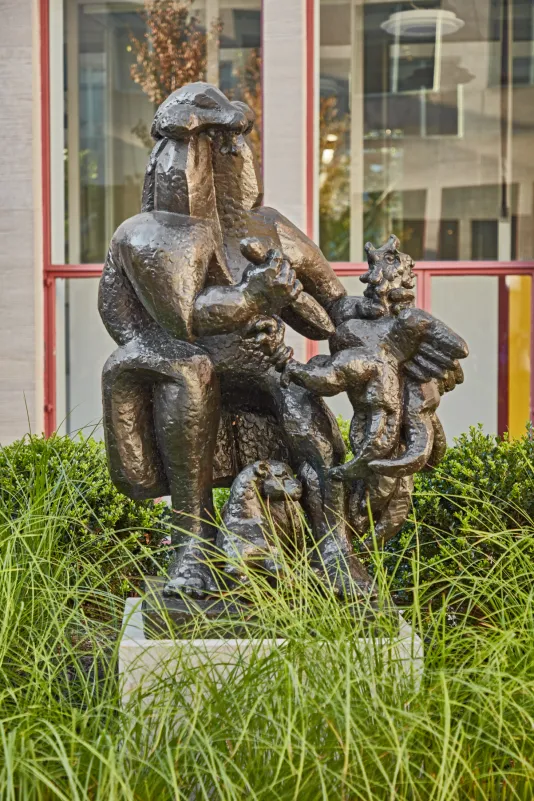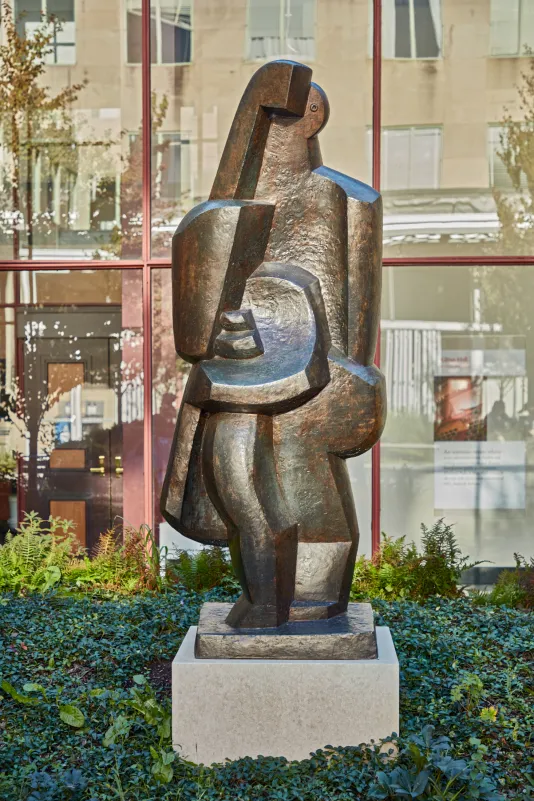Jacques Lipchitz, Sacrifice III, 1949. Gift of Yulla Lipchitz in Memory of Dr. Jerome B. Wiesner. Photo: Charles Mayer Photography
Sacrifice III, 1949

"3 Piece Flavor" by Lupe Fiasco, GHOTIING MIT: Public Art
After his escape from the German occupation of France in 1941, sculptor Jacques Lipchitz frequently turned to images of sacrificial ceremonies that related to his Jewish heritage.
The first work he had made in this vein was a small clay sketch produced in 1925. Catalyzed by the fate of European Jews during World War II, Lipchitz returned to the theme in 1943, and in 1946 he began the series of drawings, clay studies, and finished sculptures that led directly to Sacrifice III, which he modeled in 1949 and cast in bronze in 1957.
Lipchitz remarked in a 1961 interview with painter Frederick S. Wight that this and other works in the series depicted “a certain ritual which we perform on a certain occasion. We are charging some kind of a cock with all our sins, and we are offering this animal full of our sins for expiation.” His initial image of this ritual was made in 1943, “during the darkest moment of Hitler,” he recalled. “I charged the animal […] with all our sins and I prayed, it is like a real prayer, and afterward I had to sacrifice the cock.” The bronze version of this image appears to depict three subjects: the tall cloaked figure holds a dagger to the chest of a small winged creature held in his other fist. Between the human’s legs sits another animal resembling a dog. While the subjects’ bodies are imaginatively stylized, the demonstrated action is solemn, and laden with the tragedy of the Holocaust.
Jacques Lipchitz (1891–1973) was born in Lithuania as Chaim Jacob Lipchitz. After studying engineering at a secondary school in Vilna, he moved to Paris in 1909, where he attended classes at the city’s prestigious École des Beaux-Arts, Académie Julian, and Académie Colarossi. From the stylized figurative sculpture of his early years in Paris, Lipchitz’s work gradually developed as he absorbed ideas from Cubist painters of his time. By 1915, he had evolved a fully Cubist sculptural idiom. Lipchitz worked in France until the German invasion in 1940, after which he immigrated to New York. From that point on, his sculpture became more narrative and autobiographical, emphasizing biblical or personal themes. Lipchitz exhibited regularly in exhibitions in Paris beginning in 1912 and received the first of numerous solo exhibitions in 1920. His works have been displayed at the Petit Palais, Paris; Portland Museum of Art, Maine; Museum of Modern Art, New York; the 26th Venice Biennale (1952); Corcoran Gallery, Washington, D.C.; San Francisco Museum of Art; Walker Art Center, Minneapolis; Detroit Institute of Arts; the Metropolitan Museum of Art, New York; and numerous other international venues. Lipchitz is especially remembered at MIT for his support of the Institute’s program in the arts. In 1965, students enrolled in Professor Stanford Anderson’s seminar on modern art were invited to tour his studio in New York.

